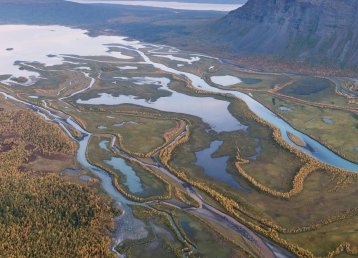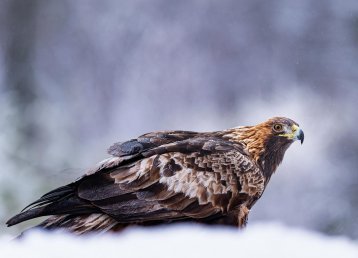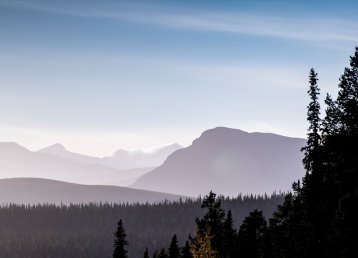Reindeer (Rangifer tarandus)
The reindeer is a species of deer and very common in the north of Sweden. It roams the forest in herds and days are mostly spent eating, exclusively vegetarian food. In winter, food consists largely of various kinds of lichen, and in summer the diet is supplemented with grass, leaves and mushrooms.
The wild reindeer went extinct sometime during the 19th century, meaning that today all reindeer are so-called domestic reindeer, owned by and looked after by the Sámi. The reindeer is one of the most useful animals in the world, both before and after it’s slaughtered. It can be used for pulling sleighs, for example, and the female can be milked the same way as cattle. After slaughter, nearly every single part of the reindeer is used for various purposes. The Sámi have always been skilled when it comes to using as much as possible from the animal, and everything has its use. Apart from the meat, with a mild taste of the game, the hides can be prepared and used for clothes or seating material.
Driving along the roads of Swedish Lapland you have to be prepared for a herd of reindeer appearing at any point, walking along the side of the road, or standing in the middle of it. Hooting your horn is pointless in most cases, and all you can do is sit back and wait until they decide to amble back into the forest.
Also read
Visut – a story of the reindeerIf you’d like a closer look at the reindeer, sometimes all it takes is a drive along the route E10, for example, or you can meet with the reindeer at Nutti Sámi Siida in Jukkasjärvi, or at Pite Havsbad where there are reindeer in a huge enclosure in winter.
Grey Seal (Halichoerus grypus)
The grey seal is an aquatic mammal that moves a good deal smoother in water than on land. This might seem a bit strange, as it needs to breathe air and lacks gills as well as oxygen tanks. The grey seal enjoys hanging out with friends, but not too many of them. It’s a superb fisherman, and if it gets really hungry, it can dive as far down as 100 metres straight into the depths of the sea to find food. It can stay down there for 20–25 minutes if needed. A real favourite on the menu is herring, but any kind of fish will do.
The seal only really spends time on land when it wants a rest, or when giving birth. If it’s up to the seal, it prefers giving birth on an ice floe where it stays for a couple of weeks until the pup – the name for seal babies – is big enough to fend for itself.
If you’re curious about seals you should go on a seal safari with Guide Natura in the archipelago, organised on certain days in summer.
Arctic Fox (Alopex lagopus)
The Arctic fox lives on bare mountains and tundra and is well adapted to the Arctic climate with fur on its pads and a thick, insulating pelt. Most Arctic foxes are white in winter and brown in summer, but they can also have a bluish-black colour all year round.
The Arctic fox is monogamous and prefers living as a couple. But sometimes a cub from last year is allowed to stay an extra year with mum and dad, and sometimes a couple will move in with other couples to form a little pack. Their dens are dug underground, and it’s not uncommon for them to have up to 10 entrances and exits.
They prefer eating lemmings, but they’re not that picky. They eat what they can get their paws on, be it frogs, rodents, mice, birds, eggs or carcasses. Arctic foxes are largely scavengers and gladly dig into the remains of anything that other animals have killed and finished eating.
The Arctic fox has been a protected species since 1928, and unfortunately, there aren’t that many of them. The number of Arctic foxes in Sweden and Norway is a mere 300 adult individuals, which makes them difficult to find in the wild.
If you want to get a glimpse of these cuties you can find them in one of the zoos that keep them or go on an Arctic Fox Safari with Geunja in Vindelfjällen nature reserve for a chance to see them in their natural habitat.
Otter (Lutra lutra)
The otter is a nimble and playful character that belongs to the weasel family. It’s highly adapted to a life in water with webbed toes and ears and nostrils that can be opened and closed. They are skilled swimmers and can stay underwater for up to five minutes. On land, they move in leaps, but never far from water. Their diet consists mainly of fish, but every now and then they eat frogs, crabs, birds and small mammals. As long as it’s meat, the otter is quite satisfied.
During spring-winter males and females live like ‘married couples’, but in summer they prefer the single life in a territory of their own.
Otters prefer living in slow-moving water that isn’t very deep, with dense vegetation along the banks. They like building their dens in cavities along the bank. They seem to be most active during twilight and in the night time. Taking that into account it can be difficult to spot an otter, but if you’re keen on trying we’d recommend you look for a remote river with a lot of vegetation. Tracks along the river edges reveal the otters, and apart from tracks, you might find slides in the snow created as they slide down slopes and banks.
Also read
Coffee made by lemmingsNorway lemming (lemmus lemmus)
The lemming is a fairly large, hamster-like rodent that’s easy to recognise with their black, yellow and rust-coloured fur. As a species, it’s probably most known for the so-called lemming years when they multiply ferociously and start wandering off the mountains.
They leave to find food and if they come across running water, they’ll either try to walk around it or swim across it. This is the end of the line for some of them but still doesn’t explain the long-lived myth about the animals committing mass suicide when conditions get tough.
The Norway lemming can grow to a mighty 15 cm and has two very large front teeth. The roots of these front teeth are so-called open roots, which means the teeth never stop growing but are worn down by gnawing as they eat or build houses. Lemmings are exclusively vegetarian and like all kinds of plants found in the region. If it’s allowed to choose it opts for a diet of moss, grass and herbs.
The lemming population varies in cycles with some regularity and peaks occur every 3–5 years. If it’s a true lemming year, there might be as many as 100-250 individuals per hectare (slightly bigger than a football pitch).
If you want to meet lemmings, try to visit when a lemming year is predicted and walk up a mountain. Preferably with a bag of Lemmelkaffe in your backpack.



























